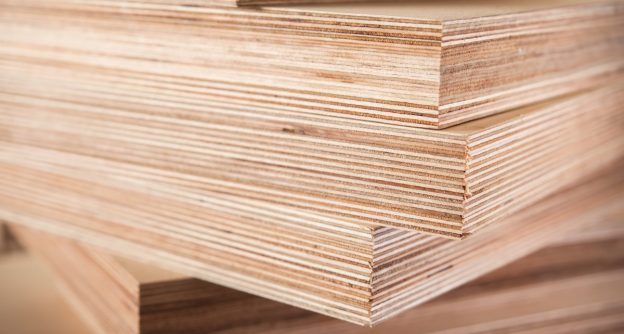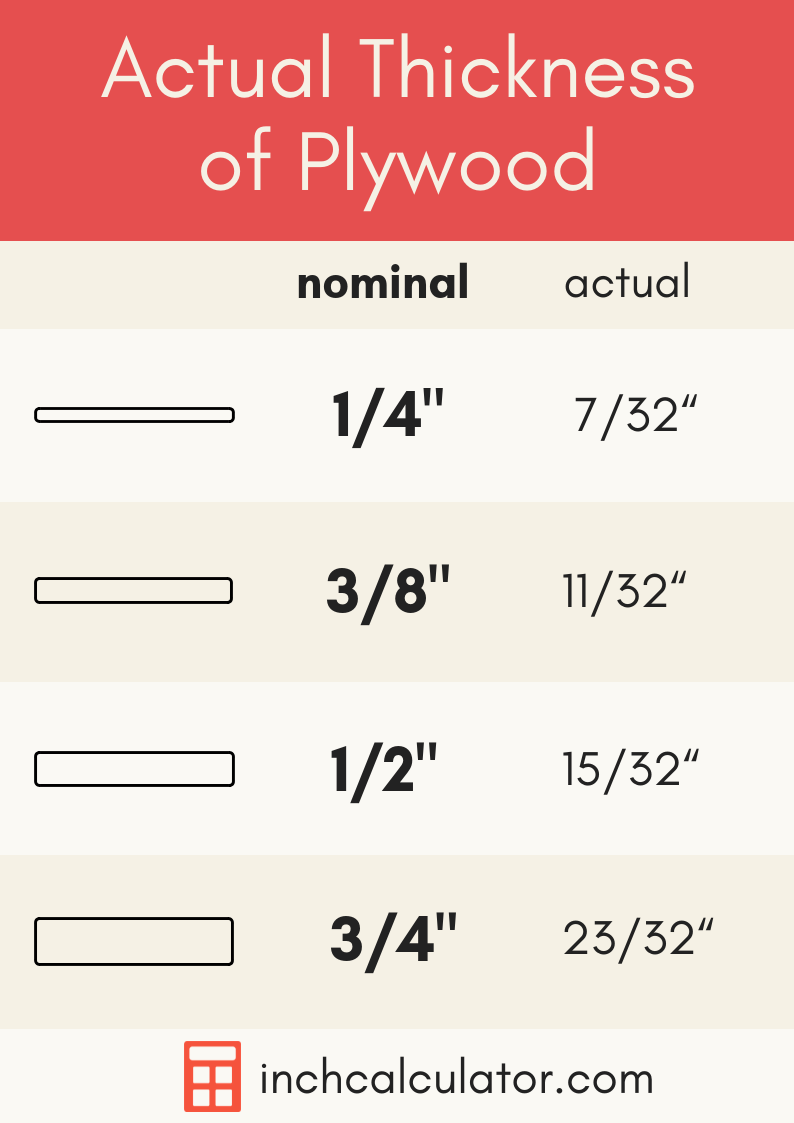Actual Plywood Thickness and Size

Plywood is a wood panel that is composed of several thin layers, or plies, of wood veneer. The wood is peeled from a log in thin sheets; different types of wood will yield different thicknesses of veneer.
The veneers are glued perpendicular to each other, creating a cross-grain pattern that is much stronger than solid wood.
Plywood sheet goods are available in various thicknesses and sizes and are typically sold by their nominal thickness, as well as by the number of plies – 3 ply and 5 ply being common. While the length and width are often the actual dimensions, the nominal thickness is usually different from the actual thickness.
For example, a sheet of plywood with a nominal thickness of 3/4” is often less than 3/4” thick. This introduces challenges when precision measurements are needed, such as determining clearance when using the plywood as an underlayment for flooring or countertops.
What is the Actual Thickness of a Sheet of Plywood
Plywood is often sold in 1/4“, 1/2“, or 3/4” nominal thicknesses, but the actual thickness is often 1/32” thinner. Because the actual thickness may vary, measuring the plywood sheet using a caliper is the only accurate way to determine its thickness.
- A 3/4” sheet is actually 23/32” thick.
- A 1/2” sheet is actually 15/32” thick.
- A 1/4” sheet is actually 7/32” thick.
The exception to this rule is plywood sheets that are over an inch thick. 1-1/4″ and 1-1/8″ plywood sheets are generally true sizes and not nominal. This may vary by manufacturer, though, so always check if you need a precise size or measurement.
Keep in mind, that while many sheets of plywood are also sold by the number of plies, that veneers and plies can have different thicknesses as well, depending on the type of wood used. So, a 3 ply sheet – one of the most common – may measure 2mm or 3mm in thickness, depending on what wood was used in its manufacturing.
It is important to keep in mind, that regardless of the thickness of the sheet, that the more plies it has, the stronger it will be. Therefore, a multi-ply sheet with 9 plies that measures a nominal 3/4″, will be stronger than a sheet with 5 plies that also measures 3/4″.
For some applications, such as sheathing a roof, the 1/32” difference is not important, but for fine carpentry, it may be critical to get grooves and cuts to be precisely the thickness of the plywood.
For example, a groove for a cabinet door panel needs to be the exact thickness of the plywood, or the door will not be stable due to the loose fit of the parts, and it will likely rattle each time it’s opened or closed.
Precision is important for trim carpentry as well; when installing wainscoting panels, if a cut doesn’t match the exact plywood thickness the final result will have noticeable gaps.
Likewise, if you are using plywood as an underlayment, you often need precise measurements of the height of the finished surface. For example, a floor may need to meet up with another material in an adjacent room; you need to know the exact thickness of the underlayment and the material on top to match it with the next space.
Why is a 3/4” Sheet of Plywood Less Than 3/4” Thick?

There are a few reasons why the actual thickness of plywood varies. First, wood shrinks as it dries and moisture leaves the wood. This means that a sheet of plywood that started at 3/4” may shrink slightly after manufacturing.
Plywood also uses glue to hold the various sheets together. The amount of glue will swell the wood slightly during manufacturing; it will then shrink as it dries. In addition, plywood comes in many types. A “finish” sheet of plywood, used for surfaces like cabinets or furniture will be sanded. This will remove a small amount of thickness of the material as well.
Another reason for varying plywood thicknesses is the range of manufacturing tolerances. Sheets are available in hardwood or softwood veneers and in varying grades, including sanded and unsanded. These different grades have different manufacturing tolerances and may vary more or less from the 3/4” nominal thickness.
Plywood is almost always thinner than the nominal measurement due to the fact that most tooling in furniture and cabinet factories and manufacturing facilities can accommodate plywood that is thinner than expected but not thicker than expected. For this reason, it is very common to see actual thicknesses on the thinner side and rarely thicker than the nominal measurement.
A 3/4” (19 mm) sheet of plywood is typically 23/32” (18 mm).
It’s not just plywood; the actual size of dimensional lumber is also smaller than the advertised nominal dimensions for this reason as well. In fact, most building materials have nominal measurements for a wide range of reasons.
Some are to accommodate swelling and shrinking of material, while others are factoring in a space that may be left between materials during installation. Because this practice is so common, it’s always a good idea to measure your building materials carefully if you need precise tolerances or clearances in your work.
Common Plywood Dimensions
Plywood is most often sold in 4′ x 8′ sheets, but may also be available in 4′ x 10′, 4′ x 12′, or 2′ x 4′ sheets. Hardwood plywood (e.g. birch, maple, oak, cherry, etc.) is often available in 4′ x 8′, 5′ x 5′, and 2′ x 4′ sheets.
Softwood plywood may be thicker than hardwood plywood, due to the need for additional plies to lend stability and structure to the sheet.
MDF, or medium-density fiberboard, is another sheet good that is sold in 4′ x 8′ sheets. Usually, the actual dimensions of an MDF sheet are oversized by one inch, and the full sheet is typically 49″ x 97″.
You can use a plywood calculator to estimate the number of 4′ x 8′ sheets needed for a project.
Plywood is usually sold by the sheet, but in some rare cases, it may be sold by the board foot. Board footage is a measure of the volume of wood in the sheet, and to calculate it, you can use a board footage calculator or calculate the cubic inches and divide by 144.
One board foot is the measurement of 144 cubic inches, or 12″ long by 12″ wide by 1″ thick.
Plywood Thickness Chart
| Nominal Thickness | Actual Thickness (inches) | Actual Thickness (millimeters) |
|---|---|---|
| 1/8“ | 7/64“ | 2.7 mm |
| 1/4“ | 7/32“ | 5.5 mm |
| 3/8“ | 11/32“ | 9 mm |
| 1/2“ | 15/32“ | 12 mm |
| 5/8“ | 19/32“ | 15 mm |
| 3/4“ | 23/32“ | 18 mm |
| 1-1/8“ | 1-1/8“ | 28.5 mm |
| 1-1/4“ | 1-1/4“ | 31.75 mm |
The weight of a panel will vary by thickness and type. Learn more about plywood weight for different types, including softwood, hardwood, marine-grade, OSB, MDF, MDO, and particle board.



